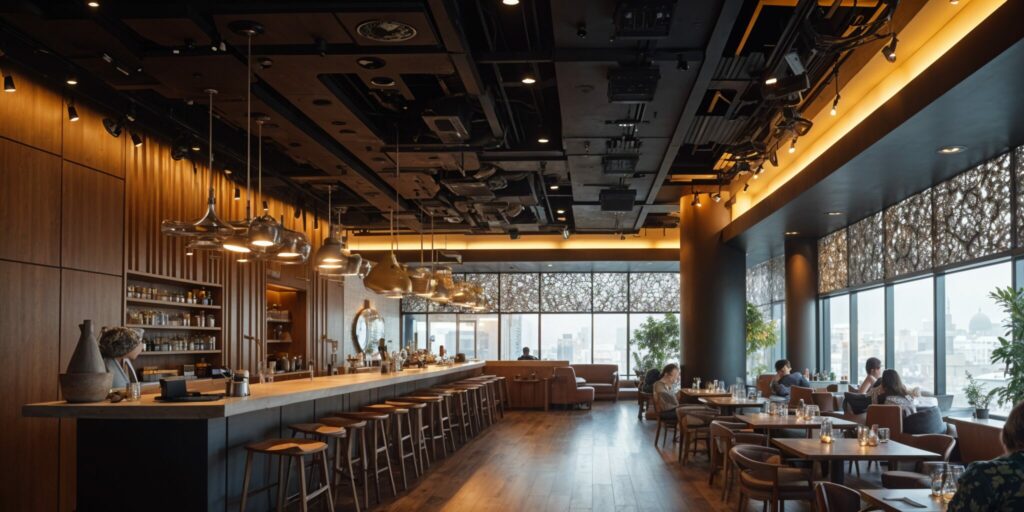In this article, we’ve compiled a comprehensive list of the top 10 commercial audio systems that are perfect for restaurants of all sizes and styles. From sleek designs for upscale establishments to budget-friendly options for casual eateries, we’ve got you covered. We’ll explore each system’s key features, specifications, and ease of installation to help you make an informed decision for your restaurant’s audio needs.Without further ado, let’s dive into our top picks for the best commercial audio systems for restaurants:
| System | Description | Key Specs | Ease of Installation |
|---|---|---|---|
| Bose DesignMax Sound System | Exceptional sound quality and sleek design for upscale restaurants. | Pendant and surface-mount; 100W power; 65 Hz – 20 kHz range. | Moderate – professional installation recommended |
| Sonos Era 100 Wireless System | Versatile and user-friendly with excellent sound and easy wireless control. | Wi-Fi/Bluetooth; Voice control; Trueplay tuning technology. | Easy – plug-and-play setup |
| JBL Control 24CT Micro Speaker System | Compact and powerful, ideal for smaller restaurants or lower ceilings. | 4″ woofer; 80W power; 70V/100V transformer taps. | Moderate – in-ceiling mounting required |
| Rockville 6-Zone Amp and Wall Speakers | Great multi-zone control for larger restaurants with different areas. | 6 zones; Bluetooth; 1000W peak power. | Moderate – wall-mounting required |
| Polk Audio OWM3 Multi-Angle Speakers with Onkyo TX-NR757 Receiver | Budget-friendly option with good sound for background music. | 100W power; 7.2 channels; 100W power handling. | Easy to moderate – flexible mounting options |
| JBL 24 Drop-Ceiling Speakers with Rockville 6-Zone Multi-room Amp | Comprehensive coverage and zone control for large restaurants. | 24 speakers; 6 zones; Bluetooth/RCA inputs. | Complex – professional installation recommended |
| Bose FreeSpace FS2P Pendant Speakers | High-quality sound in stylish design for open ceiling concepts. | 100W power; 83 Hz – 19 kHz; weather-resistant. | Moderate – hanging installation required |
| QSC K.2 Series Powered Speakers | Versatile powered speakers for live music or events. | 2000W Class D; DSP presets; XLR/RCA inputs. | Easy – stand or pole-mounted |
| Yamaha VXS Series Commercial Installation Speakers | Reliable and cost-effective option for quality sound. | 8″ woofer; 90° coverage; paintable. | Moderate – wall or ceiling mounting |
| Atlas Sound FAP63T Strategy III Series Ceiling Speakers | Excellent sound dispersion, suitable for standard drop ceilings. | 6.5″ driver; 60W power; 70.7/100V transformer. | Moderate – in-ceiling mounting required |
What are the top features to look for in a commercial sound system
Audio Quality and Coverage
The most critical aspect of any sound system is the quality and coverage of audio it provides. Look for:
- Clear, balanced sound reproduction across the full frequency range
- Even sound distribution throughout the space
- Sufficient power to provide adequate volume without distortion
Zoning Capabilities
Multi-zone functionality allows you to control audio separately in different areas1. This enables:
- Customized volume levels for different sections (e.g. bar vs. dining room)
- Playing different audio content in separate zones
- Turning audio on/off in specific areas as needed
Ease of Control
User-friendly control interfaces are essential for staff to manage the system efficiently5. Look for:
- Centralized control via touchscreen, mobile app, or wall-mounted panels
- Intuitive interfaces for adjusting volume, selecting audio sources, etc.
- Ability to create presets or schedules for different times of day
Expandability and Flexibility
Choose a system that can grow with your needs5. Key aspects include:
- Modular design allowing additional speakers/zones to be added
- Compatibility with various audio sources (streaming, local storage, etc.)
- Ability to integrate with other systems (e.g. video, lighting)
Durability and Reliability
Commercial systems need to withstand continuous use. Prioritize:
- High-quality components built for commercial applications
- Weather-resistant options for outdoor areas
- Robust connectivity to prevent dropouts
Connectivity Options
Modern systems should offer multiple ways to connect audio sources2, such as:
- Bluetooth for wireless streaming
- Wi-Fi for network audio
- Analog and digital inputs for wired connections
By focusing on these key features, you can select a commercial sound system that delivers excellent audio quality, operational flexibility, and long-term value for your business. Remember to consider your specific needs in terms of space, budget, and intended use when evaluating options.


